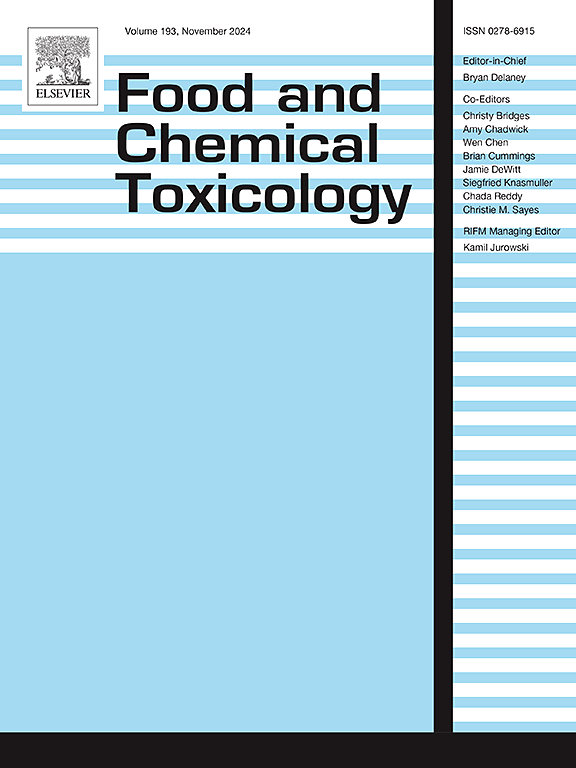长期暴露于低剂量聚苯乙烯微塑料和纳米塑料对人类ipsc来源的心肌细胞的毒性
IF 3.9
3区 医学
Q2 FOOD SCIENCE & TECHNOLOGY
引用次数: 0
摘要
微塑料和纳米塑料(MNPs)是广泛存在的环境污染物,对人类健康具有潜在风险,包括心血管影响。然而,MNPs对心脏的影响,特别是在与人类相关的心脏模型中,仍然知之甚少。在本研究中,我们研究了聚苯乙烯(PS) MNPs-1 μm (PS-1)和0.05 μm (PS-0.05)对人ipsc源性心肌细胞(hiPSC-CMs)的长期影响。PS MNPs暴露以时间和剂量依赖的方式降低心肌细胞活力。在0.1 μg/L低剂量下,PS-0.05和PS-1均能抑制心肌细胞收缩力,降低Ca2+瞬态振幅,改变收缩和Ca2+瞬态动力学。在肥厚性hiPSC-CMs中,PS-0.05暴露加剧了肥厚,增加了细胞大小和proBNP表达(肌细胞肥厚的标志)。PS mnps诱导心脏毒性的机制可能与线粒体功能障碍有关,如线粒体膜电位降低、线粒体ROS增加和细胞内ROS水平升高。这是第一项评估低剂量MNPs对人类心肌细胞长期影响的研究,为MNPs潜在的心脏毒性及其对人类心脏健康的影响提供了重要的见解。本文章由计算机程序翻译,如有差异,请以英文原文为准。

Toxicity of long term exposure to low dose polystyrene microplastics and nanoplastics in human iPSC-derived cardiomyocytes
Microplastics and nanoplastics (MNPs) are widespread environmental pollutants with potential risks to human health including cardiovascular effects. However, the impact of MNPs on the heart, particularly in human-relevant cardiac models, remains poorly understood. In this study, we investigated the long term effects of polystyrene (PS) MNPs-1 μm (PS-1) and 0.05 μm (PS-0.05) in human iPSC-derived cardiomyocytes (hiPSC-CMs). PS MNPs exposure reduced myocyte viability in a time- and dose-dependent manner. At a low dose of 0.1 μg/L, both PS-0.05 and PS-1 suppressed myocyte contractility, reduced Ca2+ transient amplitude, and altered contraction and Ca2+ transient dynamics. In hypertrophic hiPSC-CMs, PS-0.05 exposure exacerbated hypertrophy, increasing cell size and proBNP expression, a marker of myocyte hypertrophy. The mechanism of PS MNPs-induced cardiotoxicity likely involved mitochondrial dysfunction, as indicated by decreased mitochondrial membrane potential, increased mitochondrial ROS, and elevated intracellular ROS levels. This is the first study to assess the long term impact of low dose MNPs in human cardiomyocytes, providing crucial insight into the potential cardiac toxicity of MNPs and their implications for human heart health.
求助全文
通过发布文献求助,成功后即可免费获取论文全文。
去求助
来源期刊

Food and Chemical Toxicology
工程技术-毒理学
CiteScore
10.90
自引率
4.70%
发文量
651
审稿时长
31 days
期刊介绍:
Food and Chemical Toxicology (FCT), an internationally renowned journal, that publishes original research articles and reviews on toxic effects, in animals and humans, of natural or synthetic chemicals occurring in the human environment with particular emphasis on food, drugs, and chemicals, including agricultural and industrial safety, and consumer product safety. Areas such as safety evaluation of novel foods and ingredients, biotechnologically-derived products, and nanomaterials are included in the scope of the journal. FCT also encourages submission of papers on inter-relationships between nutrition and toxicology and on in vitro techniques, particularly those fostering the 3 Rs.
The principal aim of the journal is to publish high impact, scholarly work and to serve as a multidisciplinary forum for research in toxicology. Papers submitted will be judged on the basis of scientific originality and contribution to the field, quality and subject matter. Studies should address at least one of the following:
-Adverse physiological/biochemical, or pathological changes induced by specific defined substances
-New techniques for assessing potential toxicity, including molecular biology
-Mechanisms underlying toxic phenomena
-Toxicological examinations of specific chemicals or consumer products, both those showing adverse effects and those demonstrating safety, that meet current standards of scientific acceptability.
Authors must clearly and briefly identify what novel toxic effect (s) or toxic mechanism (s) of the chemical are being reported and what their significance is in the abstract. Furthermore, sufficient doses should be included in order to provide information on NOAEL/LOAEL values.
 求助内容:
求助内容: 应助结果提醒方式:
应助结果提醒方式:


